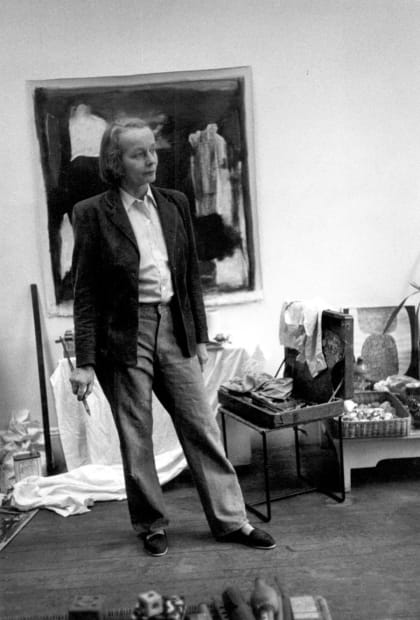-
-
Alexander Gray Associates presents a selection of paintings, sculptures, and works on paper by Ricardo Brey, Melvin Edwards, Sam Gilliam, Harmony Hammond, Jennie C. Jones, Lorraine O’Grady, Betty Parsons, Joan Semmel, Valeska Soares, and Hugh Steers. Spanning more than fifty years—from 1967 to 2021—the Gallery’s presentation highlights a half century of artistic innovation to reenvision the contemporary canon.
Advocating for an expanded understanding of painting, Sam Gilliam reimagined the limits of the medium. Works like Gilliam’s Looming (1967) revel in an unfettered approach to color and process. Created the first year Gilliam began to construct his Beveled-Edge Paintings, this canvas appears to float off the wall and into the gallery space. Defined by luminous stretches of oceanic blues, silvery grays, and verdant greens, the composition upholds the idea that free expression is in itself a form of engaged citizenship. A close friend of Gilliam—and equally inventive in his approach to abstraction—Melvin Edwards first began welding steel sculptures in the 1960s. Juxtaposing agricultural and industrial elements, his dynamic constructions are imbued with an immediacy and metaphorical power that belies their mundane materials. Recent works like Not So Easy (2019) engage with the history of race, labor, and violence to reflect on the legacy of the African Diaspora.
In contrast to Gilliam and Edwards, Betty Parsons’s approach to abstraction was purely associative. Elaborating on the flat formalism of the New York School, which her eponymous gallery championed, Parsons drew on past travel and personal experience to inform her compositions. Pseudo-geometric canvases like Teeth of the Temple (c. 1970) resonate with the “sheer energy” of the natural world she sought to capture. Like Parsons, Harmony Hammond plays with modernist precepts in her practice. Suggesting a near bodily presence, the built up surface of Marker II (2011–2020) reinvigorates the modernist language of the monochrome by infusing it with content. Also revisiting the legacy of modernism, Jennie C. Jones’s Untitled (Segue Score) Diptych #3 (2021) recalls expanded understandings of music that were advanced by Fluxus artists and composers. The diptych deconstructs the musical staff, transforming its five lines into booming crescendos. Literalizing Jones’s conceptual deconstruction, Valeska Soares peels back the canvas of her Doubleface (Cobalt Blue/English Red) (2019) painting to disrupt the composition’s blue and red planes and reveal two hidden portraits.
Meanwhile, artists like Joan Semmel and Hugh Steers looked beyond modernism for inspiration. Semmel critically responds to the art historical tradition of the female nude by centering her practice around representations of the body from a female perspective. Paintings like Time Out (2021) celebrate color and flesh while highlighting the aging process. Similarly, before his death in 1995 from AIDS, Steers mined the entirety of the western canon to construct poignant vignettes that celebrate Queer identity. White Gown (1994) and other intimate compositions recall images of women at their toilette and were deeply personal for the artist, helping him accept his sexuality and illness.
Also exploring issues surrounding personal identity, Lorraine O’Grady’s The Fir-Palm (1991/2019) presents viewers with a hybrid New England fir-Caribbean palm tree sprouting from a female torso. For O’Grady, born and raised in Boston to Jamaican parents, The Fir-Palm interrogates the nature of identity in a society rooted in—yet resistant to—physical, psychological, and cultural hybridity. Ricardo Brey’s practice further speaks to the nature of this hybridity, joining the complex visual and historical vocabularies of his native Cuba with a rigorous engagement in the Western art historical canon. Works like Cielo (2021) and Poison Tree (2020) navigate transcultural dialogues to challenge and surmount divisions between myths, religions, and systems of thought and value. As Brey once wrote, “I create into my work spaces of interaction in which I link elements that at first seem to be opposite but in reality are indissolubly connected: nature/culture, organic/inorganic, western/non-western, my goal is to transmit with my sculptures and installations … this hybrid nature, posing questions rather than answers.”
Ultimately, the works on view advocate for an expanded contemporary art history rooted in social critique and new approaches to abstraction, materiality, and representation. Spotlighting a half century of artistic developments that challenge formal and conceptual conventions, the Gallery’s presentation celebrates artists that critically respond to a changing global landscape.
-
Joan Semmel
-

Image: Joan Semmel, 2019. Photo: Taylor Miller
-
Selected works by Joan Semmel
-
Betty Parsons
-

Image: Betty Parsons at her studio, undated
-
Selected works by Betty Parsons
-
-
Sam Gilliam
-

Image: Sam Gilliam, courtesy of David Kordansky Gallery, Los Angeles. Photo: Fredrik Nilsen Studio
-
Selected work by Sam Gilliam
-
Ricardo Brey
-

Image: Ricardo Brey, 2020. Photo: Isabel Brey
-
Selected works by Ricardo Brey
-
Hugh Steers
-

Image: Hugh Steers in his studio at Yale, c. 1985
-
Selected work by Hugh Steers
-
Valeska Soares
-

Image: Valeska Soares. Photo: Vicente De Paulo
-
Selected work by Valeska Soares
-
Melvin Edwards
-

Image: Melvin Edwards, 2019. Photo: Ross Collab
-
Selected works by Melvin Edwards
-

Melvin Edwards working in his 209 East Second Street studio, New York, February 20, 1970. Photo by Fred McDarrah.
-
Lorraine O'Grady
-

Image: Lorraine O'Grady, 2018. Photo by Ross Collab
-
Selected work by Lorraine O'Grady
-
Jennie C. Jones
-

Image: Jennie C. Jones, 2020, Photo by Jason Frank Rothenberg
-
Selected work by Jennie C. Jones
-
Harmony Hammond
-

Image: Harmony Hammond, 2019. Photo: Clayton Porter
-
Selected works by Harmony Hammond
Frieze London 2021
Past viewing_room































